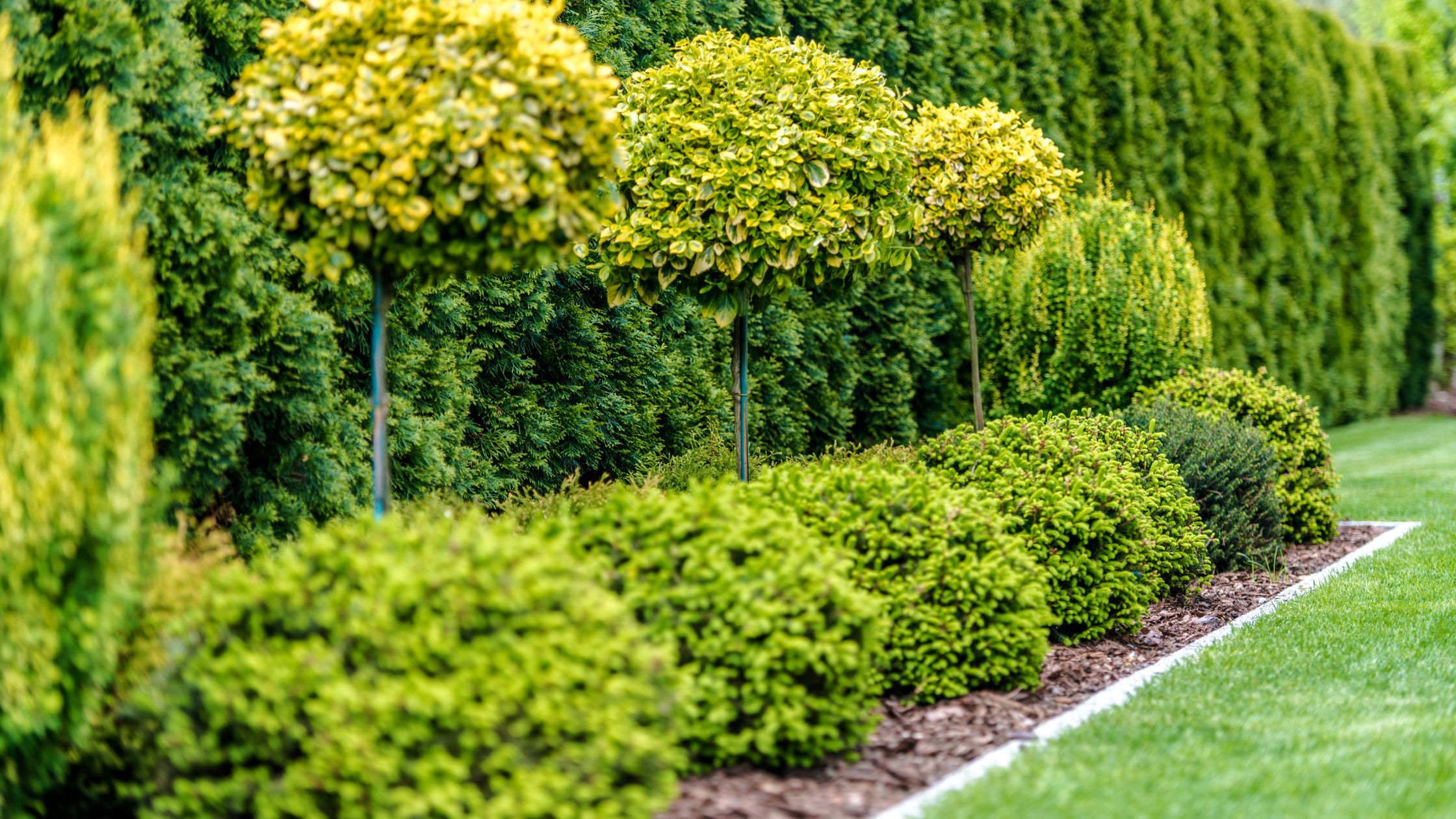Not all shrubs are created equal. Some sulk or struggle after pruning, while others come back stronger, fuller, and better looking with a good annual trim.
If you’re landscaping in Northeast Ohio (USDA Zones 6a–6b), you’ve got a wide range of hardy shrubs that actually benefit from consistent trimming — as long as it’s done at the right time and with the right technique.
At Colin Can Help, we work with these plants every day, shaping them for health, structure, and standout curb appeal. Here are the top 5 shrubs we recommend if you want beautiful, low-stress greenery that thrives with regular trimming.
✅ 1. Boxwood (Buxus spp.)
Why It’s Great:
Boxwoods are the MVP of structured landscapes — dense, slow-growing, and naturally tidy. They’re ideal for Northeast Ohio’s climate and thrive in both sun and partial shade. Whether you’re lining a walkway, framing your entry, or building a formal hedge, boxwoods respond beautifully to regular shaping. They tolerate tight geometric trims, gentle hand-pruning, and creative topiary work without losing vigor — making them a go-to for both modern and classic designs. Best of all? They stay green year-round and recover well from winter stress with a spring cleanup.
Best Time to Trim:
- Late spring to early summer is ideal.
- Avoid cutting in fall — new growth won’t harden before frost.
How We Trim It:
- Light shearing for shape
- Occasional hand pruning to thin interior branches (prevents disease)
- Avoid cutting into leafless “dead zones” — boxwood doesn’t regenerate from bare wood
💡 Bonus: Boxwoods hold their shape beautifully through winter and make great anchors for front yard design.
✅ 2. Spirea (Spiraea japonica & Spiraea x bumalda)
Why It’s Great:
Spirea is a landscaper’s dream — fast-growing, low-maintenance, and incredibly rewarding to trim. These vibrant, flowering shrubs bloom on new wood, meaning a quick spring cut encourages a fresh flush of foliage and a heavy bloom cycle. They’re perfect for borders, bed fillers, or adding color to foundation plantings, and their naturally mounded shape responds well to both light shaping and deeper annual trims. With varieties offering pink, white, or red flowers and foliage that shifts with the seasons, Spirea delivers multi-season interest with minimal effort — making it one of the best value plants for Northeast Ohio homeowners.
Best Time to Trim:
- Late winter or early spring, before new growth appears
How We Trim It:
- Cut back by ⅓ to ½ each year to maintain a mounded shape
- Remove dead stems and thin out crossing branches
- Deadhead spent blooms in summer for possible rebloom
💡 Locally popular cultivars like ‘Goldflame’ or ‘Anthony Waterer’ thrive in Northeast Ohio and color up beautifully when trimmed correctly.
✅ 3. Hydrangea (Panicle types like ‘Limelight’ or ‘Bobo’)
Why It’s Great:
Panicle hydrangeas like ‘Limelight’ or ‘Bobo’ are cold-hardy bloom machines that deliver stunning cone-shaped flowers from mid-summer into fall. Unlike fussier mophead types, these hydrangeas bloom on new wood, which means they love and benefit from a hard spring cutback. With just one annual trim, they grow back fuller, more balanced, and often bloom even more prolifically. Their strong stems hold up well against wind and rain, and their flower heads dry beautifully for off-season interest. In Northeast Ohio’s shifting climate, panicle hydrangeas are a reliable, low-drama choice for big color and bold texture.
Best Time to Trim:
- Late winter to early spring (March is usually safe)
How We Trim It:
- Cut back by about ⅓ to ½ to shape and reduce size
- Remove weak or damaged canes at the base
- Avoid trimming in fall (risk of frost damage and reduced bloom size)
💡 Don’t confuse these with mophead hydrangeas — those require a gentler touch and more precise timing.
✅ 4. Ninebark (Physocarpus opulifolius)
Why It’s Great:
Ninebark is a native powerhouse — tough, fast-growing, and packed with four-season interest. Its colorful foliage (ranging from deep burgundy to copper and lime green), exfoliating bark, and arching branches make it a standout even when not in bloom. Best of all, it responds beautifully to structured annual trimming or deeper rejuvenation cuts. Whether you’re using it as a privacy screen, backdrop in a bed, or a focal point in a native garden, Ninebark tolerates heavy pruning, recovers quickly, and thrives in Northeast Ohio’s climate — even in less-than-perfect soil.
Best Time to Trim:
- Late winter or early spring before bud break
How We Trim It:
- Cut back by ⅓ for shape control and fuller growth
- Thin interior branches to reduce overcrowding
- Rejuvenation pruning every 3–4 years if needed
💡 ‘Diablo’ and ‘Summer Wine’ are especially popular in the Heights and eastern suburbs — great color contrast in mixed beds.
✅ 5. Weigela (Weigela florida)
Why It’s Great:
Weigela offers the best of both worlds: bold spring blooms and easy care. With trumpet-shaped flowers that attract hummingbirds and long-lasting color that blends beautifully with other perennials, Weigela is a favorite for front-yard displays and mixed borders. It responds well to regular thinning and post-bloom pruning, which encourages dense regrowth and repeat blooming on some varieties. In Northeast Ohio’s climate, it handles cold winters without issue and rebounds with vigor come spring. Plus, modern cultivars like ‘Wine & Roses’ offer dark foliage that adds contrast and drama all season long — with very little upkeep.
Best Time to Trim:
- Immediately after blooming (usually late May to early June)
How We Trim It:
- Remove about ⅓ of oldest stems each year (to the ground) to encourage new shoots
- Lightly shape to maintain roundness
- Remove dead wood and thin as needed
💡 ‘Wine & Roses’ and ‘Red Prince’ are common in local nurseries and perfect for layered landscapes near patios or front walks.
🌱 Honorable Mentions for Northeast Ohio:
These shrubs also respond well to routine maintenance:
- Arborvitae (Thuja spp.) – great for hedge trimming, just don’t cut past the green
- Forsythia – spring blooms + major rejuvenation potential if overgrown
- Burning Bush (Euonymus alatus) – thrives with shaping, but invasive in some areas (check local restrictions)
- Yews (Taxus spp.) – versatile for both foundation planting and formal hedges
✂️ Why Annual Trimming Works
- Healthier growth — fewer dead zones, better airflow
- More blooms — especially for new-wood flowering shrubs
- Less maintenance over time — no major “rescue cuts” needed
- Improved shape and structure — shrubs look neater, even in the off-season
- Increased property value — polished landscapes suggest a well-maintained home
🧰 How Colin Can Help
We don’t just show up and start cutting. Our process ensures:
- Proper identification of each shrub on your property
- Strategic cuts based on bloom cycles, species needs, and client goals
- Cleanup so your yard looks ready for photos, guests, or just your own pride
- Optional maintenance plans — so you don’t have to guess when to call us next
Whether you’re managing a few foundation shrubs or coordinating a full seasonal cleanup for a real estate listing, Colin Can Help keep your landscape low-stress and high-impact.
✅ Final Takeaway: Trim the Right Shrubs at the Right Time
The best yards don’t happen by accident — they’re shaped (literally) by consistent, informed care. These five shrubs give you beauty, durability, and low drama if you commit to annual trimming.
If you’re ready to put your shrubs on a health plan — not just a haircut —
Request a quote today and we’ll make sure your landscape stays sharp, season after season.
If you are looking to add more plants to your landscape and are in the Cleveland area, we always recommend stopping by Highland Garden Center. They have been helping me get great plants for projects for over a decade.

